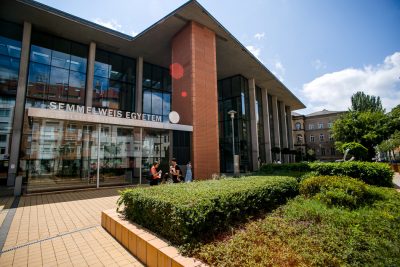 Due to the increased attention nanosciences have gained in the past few years, the Semmelweis University Nanoscience Network was founded with two main goals, Research and Education. In this regard the Laboratory of Nanochemistry was established on July 1st 2010. In terms of organizational structure while situated in NET building, the Laboratory of Nanochemistry falls under the directory supervision of the Department of Biophysics and Radiation Biology. The research group’s purpose is the study of micro and nano sized materials intended for medical, pharmaceutical, biological and environmental applications.
Due to the increased attention nanosciences have gained in the past few years, the Semmelweis University Nanoscience Network was founded with two main goals, Research and Education. In this regard the Laboratory of Nanochemistry was established on July 1st 2010. In terms of organizational structure while situated in NET building, the Laboratory of Nanochemistry falls under the directory supervision of the Department of Biophysics and Radiation Biology. The research group’s purpose is the study of micro and nano sized materials intended for medical, pharmaceutical, biological and environmental applications.
Research is divided into two main directions:
-Synthesis and characterization of biocompatible colloidal particles designed as contrast materials or drug-carriers (Drug Delivery Systems). One of focus point of diagnostic imaging research is the fabrication of a multifunctional contrast agent that is not only able to demonstrate the structural but the functional state of a system as well. One of our goals is the assembly of protein-covered, magnetic nanoparticles marked with radioisotopes that could be used in MRI and PET imaging as contrast agents. Future plans involve the synthesis and functionalization of magnetic fluids and gels for hyperthermic chemotherapy applications with tissue specific heat conductivity and thermic stability .
-Materials can be classified as biological (biomaterials) or synthetic materials. While biomaterials are ubiquitously found in nature as structural components of any living organism, synthetic materials are artificially produced. Synthetic materials that are designed to be structurally or functionally similar to biological counterparts (imitating nature) are termed biomimetic materials. The group’s purpose is to design and fabricate 3rd generation, primarily polymer based, biological and biomimetic materials with biocompatible and/or biodegradable properties that could eventually be utilized as nano sized matrices for tissue engineering, implants for guided and regulated drug delivery, polymers with regulated biodegradation, self-assembly structures, artificial muscle tissues and polymer gels with biomimetic receptors for molecular imprinting.
We would like to continue our endeavours by cooperating with other research groups within the university’s nanoscience network, the Drug Discovery and Safety Centre or any interest clinical department.
Jedlovszky-Hajdú, Angéla PhD
Head of the Research Group
Associate professor